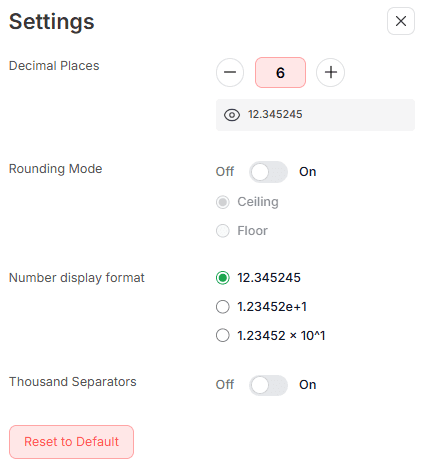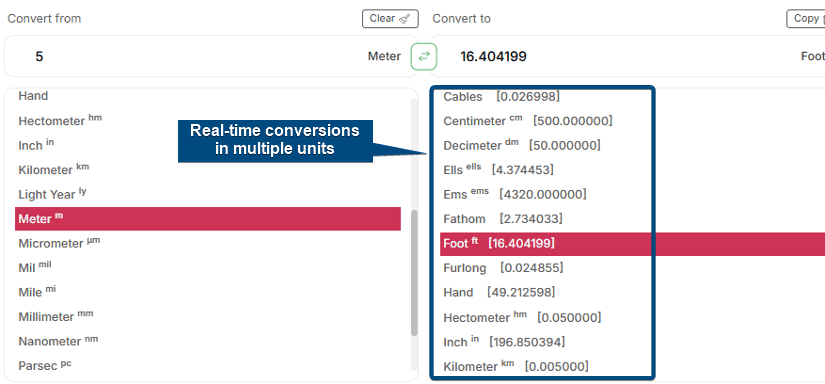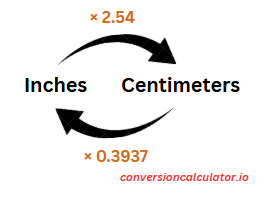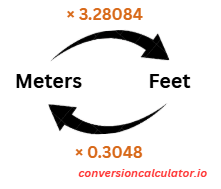HomeLength Converter
Length Conversion Calculator
From nanometers to light-years, convert distances across any scale.Length Converter
Convert from
Convert to
**Formula:
Discover Other Unit Converters
Try Other Length Converters
Angstrom to CentimeterAngstrom to FootAngstrom to InchAngstrom to KilometerAngstrom to MeterAngstrom to MicrometerAngstrom to MillimeterAngstrom to NanometerAngstrom to PicometerAstronomical Unit to AngstromAstronomical Unit to CentimeterAstronomical Unit to FootAstronomical Unit to KilometerAstronomical Unit to Light YearAstronomical Unit to MeterAstronomical Unit to Mile
Updated on September 1, 2025
Our Length Conversion Calculator is a quick and accurate online tool that helps you convert between different length units such as meters, feet, inches, and kilometers. It makes unit conversions easy and saves your time by giving precise results in just a few clicks. With support for 25 different units, you can switch between them smoothly without worrying about manual calculation errors. In this article, I’ll explain how the calculator works, the units it covers, and the simple formulas behind the conversions.About Our Length Conversion Calculator
Written By Nadiba Rahman
Nadiba Rahman
Reviewed by Mrinmoy Roy
Mrinmoy Roy
Share This Post
URL copied!
What is Length?
Length is a measure that describes how long something is or the distance between two points. It is a basic concept used in everyday life to compare objects' size, shape, and position.In simple terms, length refers to the longest side of an object when placed horizontally. For example, if you’re looking at a rectangle, the longer edge is called the length, while the shorter edge is the width. Height is the vertical measurement from top to bottom.

To measure length, you usually need a tool. Common tools include rulers, tape measures, and measuring wheels. These tools have marked units so you can compare the object’s length to a standard scale. In modern settings, devices like laser distance meters, GPS, or lidar can measure length without physical contact.
Common Length Measurement Systems
Length is measured using two main systems: the Metric system and the Imperial / US Customary system.1. Metric System
The metric system, also known as the International System of Units (SI), is used worldwide. Its base unit of length is the meter (m). This system uses prefixes like ‘kilo’, ‘centi’, and ‘milli’ to represent multiples or fractions of a meter, forming units such as kilometer (km), centimeter (cm), and millimeter (mm). For example,
- 1 kilometer (km) = 1,000 meters
- 1 centimeter (cm) = 1/100 of a meter
- 1 millimeter (mm) = 1/1,000 of a meter
2. Imperial / US Customary System
The imperial system / US customary system is mainly used in the United States and a few other countries. It developed from old British imperial units and includes common units like foot, inch, thou, yard, and mile.
How to Convert Between Length Units?
To convert between length units, follow a simple two-step process:- Convert the source unit to the base unit (Meter).
- Convert the base unit to your desired unit.
Conversion Units Available in Our Length Converter
Our length conversion calculator supports 25 different length units. They are:- Angstrom (Å): A tiny unit of length equal to 10⁻¹⁰ meters, often used to measure atomic and molecular dimensions.
- Astronomical Unit (AU): The average distance from Earth to the Sun, about 149.6 million kilometers (or ~93 million miles).
- Cables: A unit used in maritime navigation and shipbuilding, equal to 185.2 meters.
- Centimeter (cm): A metric unit of length, where 1 cm = 0.01 meters.
- Decimeter (dm): A metric unit equal to 0.1 meters, often used for shorter distances.
- Ells: An old unit once used for measuring cloth, with 1 ell approximately equal to 1.143 meters.
- Ems: A typographic unit that measures the width of the letter "M" in a specific font size.
- Fathom: A unit used in navigation, equal to 6 feet or about 1.8288 meters.
- Foot (ft): An imperial unit of length, where 1 foot = 0.3048 meters.
- Furlong: A land measurement unit, where 1 furlong = 201.168 meters or 220 yards.
- Hand: Used for measuring the height of horses, where 1 hand = 4 inches or 0.1016 meters.
- Hectometer (hm): A metric unit equal to 100 meters, rarely used in daily measurement.
- Inch (in): An imperial unit of length, where 1 inch = 2.54 centimeters.
- Kilometer (km): A metric unit equal to 1000 meters, commonly used for measuring long distances.
- Light Year (ly): A unit in astronomy representing the distance light travels in one year (about 9.461 trillion kilometers).
- Meter (m): The base unit of length in the metric system, commonly used in scientific, engineering, and everyday measurements.
- Micrometer (µm): A small unit of length, equal to 10⁻⁶ meters, often used in science and engineering.
- Mil: A unit equal to 0.001 inches or 0.0254 millimeters, used in precision manufacturing.
- Mile (mi): An imperial unit for longer distances, equal to 1,609.344 meters.
- Millimeter (mm): A metric unit of length, equal to 0.001 meters, commonly used for small-scale measurements.
- Nanometer (nm): A unit for very small measurements, equal to 10⁻⁹ meters.
- Parsec (pc): Used in astronomy to measure large distances, equal to 3.26 light years.
- Picometer (pm): A very tiny unit of length equal to 10⁻¹² meters, useful in atomic and molecular measurements.
- Thou (mil): Another term for mil, equal to 0.001 inches or 25.4 micrometers.
- Yard (yd): An imperial unit equal to 3 feet or about 0.9144 meters.
How to Use Our Length Conversion Calculator?
To use our length conversion calculator, check out the following steps:- Select the Source Unit: Choose the unit you want to start with.

- Select the Target Unit: Select the target unit you want to convert to.

- Enter the Input Length Value: Enter the length value you want to convert as input.

- Get Your Desired Result: The calculator will instantly display the evaluated result in the target unit.You will also see a real-time conversion formula at the bottom of the unit section as soon as you select the units, which shows the relation between the units.


Features of Our Length Conversion Calculator
Our length conversion calculator has many useful features that make converting units fast, accurate, and easy to use. You can access all these options in the settings menu. The image below shows the default settings for each feature.
Real-Time Multi-Unit Conversion
When working with length, you may need values in multiple units like meters, feet, inches, or kilometers at the same time. Manually converting each one can be slow and repetitive.That’s why our calculator features Instant Multi-Unit Conversion. As soon as you enter a value, it automatically displays the result across all supported length units. You don’t need to convert each one individually.
For example, if you convert 5 meters to feet, the calculator will also show the equivalent results in inches, centimeters, kilometers, miles, and more, all in real time.

Custom Decimal Precision
When converting length, even a small error in decimal placement can cause misalignments, incorrect part sizes, or build issues. That’s why our length conversion calculator lets you control the exact level of precision you need.For example, if you select 10 decimal places, a result might display as 3.1415926536 instead of rounding it off too early, as shown in the image below:
Rounding Mode Control
Even small differences in length values can lead to serious problems, especially when working in construction, manufacturing, or printing projects. For example, if a metal rod measures 2.67 meters but gets rounded down to 2 meters, it could end up too short and cause part mismatches.To avoid such issues, our length conversion calculator offers a Rounding Mode feature. By default, rounding is turned off to maintain full precision. But when enabled, you can control how values are rounded based on your project’s needs.
Flexible Number Display Format
Length conversions can involve anything from extremely small units like nanometers to large distances like miles. To make values easier to work with, our calculator lets you choose the number display format that works best for your needs. You can switch between:- Standard Decimal (e.g. 1234.56789012)
- Scientific Notation (e.g. 1.2345679e+3)
- Engineering Format (e.g. 1.2345679 × 10³)
Thousand Separators Toggle
Large numbers like 18765432.75 millimeters can be hard to scan and easy to misread. That’s why our calculator includes a Thousand Separator toggle.When enabled, it automatically adds commas to separate digits, turning 18765432.75 into 18,765,432.75. This small change makes values easier to scan, reduces errors, and improves accuracy when copying or comparing multiple results.
Integrated Scientific Calculator
Need to divide a length in half or multiply it by a scale factor after converting? You don’t have to open a separate app.Our length converter includes a built-in scientific calculator that lets you perform quick calculations, such as addition, subtraction, multiplication, and division, right inside the tool. And once you’re done, you can instantly transfer the result to the converter with a single click.
Smooth and Quick Unit Swap
Instead of manually resetting units each time, use our one-click unit switch. This button instantly swaps the input and output units, letting you reverse conversions quickly. It’s perfect when double-checking results or comparing values.Clickable and Auto-Saved Conversion History
Our length conversion calculator automatically saves your last 10 conversions, even if you refresh or close your browser.This is especially handy when working with multiple measurements. Simply open the History tab and click on any past entry to reload that exact conversion. No need to retype anything.
Length Conversion Table
Download our Length Conversion Chart to find all the conversion factors and compare different length units in one place.2 Examples of Conversion With Our Length Converter
Our length converter makes it easy to switch between common length units like meters, centimeters, inches, feet, and miles. Every conversion uses a factor based on how one unit relates to another, and you’ll find all these factors in the chart above.Here’s how the basic formula works:
Converted Value = Conversion Factor × Source Value
Let’s go through two quick examples:
1. Convert Inches to Centimeters
From the chart, 1 inch = 2.54 centimeters. So, to convert 13 inches to centimeters:
13 × 2.54 = 33.02 centimeters To go from centimeters back to inches, simply multiply by 0.3937 (which is also in the chart).
To go from centimeters back to inches, simply multiply by 0.3937 (which is also in the chart).
13 × 2.54 = 33.02 centimeters

2. Convert Meters to Feet
From the chart, 1 meter = 3.28084 feet. So, to convert 7 meters to feet:
7 × 3.28084 = 22.97 feet For reverse conversion, use the factor 0.3048.
For reverse conversion, use the factor 0.3048.
7 × 3.28084 = 22.97 feet


